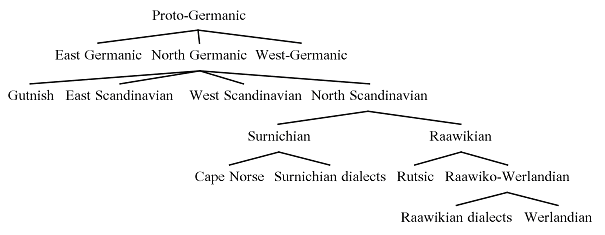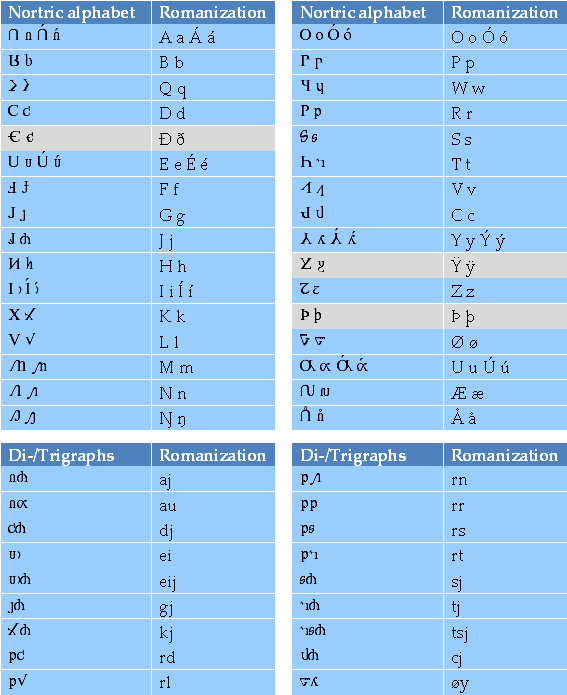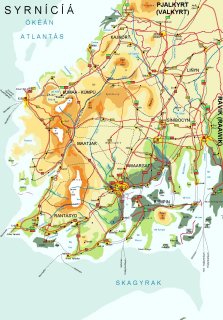Language
The Surnichian nation was formed by the unification of different relatively isolated communities in south-western Scandinavia. These communities all had their own dialects. As a consequence, still many different languages and dialects are spoken in Surnichia today. The official language of Surnichia, the language of the government and the national media, is Surnichian, which is derived from the dialect group originally spoken around the city of Jelnur. The three other main dialect groups in Surnichia are Cape Norse, which is spoken in the west, along the Atlantic coast, Rutsic, which is spoken in the east, along the Raawikian border, and Finnlingish, spoken in the north.
Finnlingish is a Saami language and belongs to the Uralic language family. It is most related to Southern Saami, but it has also taken some vocabulary from the adjacent Surnichian dialects. Cape Norse, Surnichian and Rutsic are all North Germanic languages, belonging to the North Scandinavian branch that split from Proto-Norse in the 7th century. The former two dialect groups belong to the Western branch of North Scandinavian, while Rutsic is from the Eastern branch to which also the languages Raawikian (spoken in Raawik) and Werlandian (spoken in Werland) belong. This is illustrated in the following tree graph.

Language family tree showing the relationship between Surnichian and its sister languages
The North Scandinavian languages are an early branch from the Proto-Norse language. It was spoken by a North Germanic people that split off from the tribes that were living in Southern Scandinavia in the 7th century AD, before Proto-Norse evolved into the Old Norse dialects that later led to the rising of the contemporary languages Swedish, Danish, Norwegian, Faroese and Icelandic. This people pushed north and eventually reached the area known as Finnmark, in northern Scandinavia. Here, the Germanic people cohabited with the indigenous Saami people, with whom they established trading relations and that had a significant influence on their language and culture.
In later times, the North Scandinavians headed south in search of a better life and they were scattered over southern Scandinavia, resulting in several relatively isolated Germanic communities that each developed their own language. By 1200, the dialects in the area that would later become Surnichia had sufficiently diverged from its ancestor language, and from the eastern North Scandinavian branch, that from this time they can be called 'Surnichian'. The phase of the language from 1200 until 1350 century is called 'Old Surnichian'. Most linguists distinguish a 'Middle Surnichian' phase from 1350 well into the 16th century. From 1530 onwards, the language is known as 'Modern Surnichian'. Already in the Old Surnichian phase, the language made numerous borrowings from mainly Northern Saami, Finnish and Norwegian. Later, some loanwords entered the language from immigrant languages like Czech, West-Greenlandic, Swedish and Danish.
In the twentieth century, a group of left-wing intellectuals invented an artificial language based on Latin and some West-European languages. It was meant as an attempt to bring people together through a 'universal' language, and especially to build a bridge between the Surnichian people and the rest of the world. However, attempts to acquire an official status for Euro-Latinish in Surnichia failed and the language is not used anymore.
The name 'Surnichia'
'Surnichia' is the anglicised name for the nation that is called Syrnícíá [sʀˈni.çi.ɐ] by its inhabitants. The first part of the name is probably derived from Norwegian 'sřr', meaning 'south'. The second part is from the Proto-Germanic root *nēhwa- 'near'. Thus, the name might be taken to mean '[land in the] near south'.
Alphabet
Until the nineteenth century, the Surnichian language was mostly written in the Nortric alphabet, a writing system derived from the Roman alphabet which was also used in Valkurt, Raawik and Werland. However, as Surnichia was opening up more and more to the rest of the world, an increasing number of Surnichians were calling for switching to the Latin alphabet, especially among the younger generation. A standard for romanization was developed by Ádar Jeírsant, the founder of the Surnichian Language Institute. Today, the Latin alphabet is the standard writing system in Surnichia, although the Nortric alphabet is still sometimes used, especially in poetry and literature. The following table shows the Nortric alphabet and its romanization.

Ádar Jeírsant's romanization of the Nortric alphabet. Characters on a grey background are no longer in use
